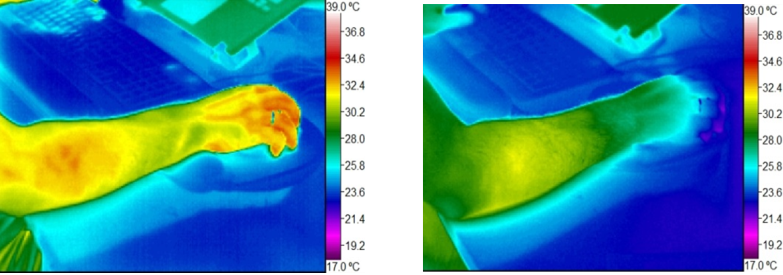How to 'spot' muscle overload?
It is no secret to anyone: if you are cold, move actively – jog or jump. Muscular work makes it possible to warm up, as the warmth is produced as a by-product of movement. But which muscles produce the most warmth while working? Is it possible to see it?
Warmth created by nature is infrared radiation – though we cannot see it, as our eyes do not see this spectrum of the electromagnetic waves, we only feel it as warmth. Furthermore, everyone feels warmth differently – an object of the same temperature for one person may seem colder, while the object may seem warmer to another person. Therefore, sometimes there is a need for precise measurements and they can be made with different measuring instruments. The most widespread, of course, are different thermometers, but to perform the measurement all of them need to come into contact with the body, or at least to be placed in its proximity to determine the temperature. Placement of the thermometer on the body is not always convenient and handy, especially, if the person is moving actively.
Special cameras were invented in the previous century, which were capable of capturing the warmth radiated by an object (or more precisely – the infrared radiation) and transform it into an image. Owing to this invention, we can “see” warmth. Historically, the first cameras were quite large and complex to operate, however, along with the new era of digital technology, infrared cameras have become much more convenient to use and the image quality has improved significantly. The method was named digital infrared thermography or thermovision. It allows measuring of the surface temperature from a distance very accurately, avoiding contact with the object. Application of thermography is not new – it is widely used in various industries for technical purposes (for example, determining the location of an overheated component in a device), in construction (for example, detecting defects in building insulation), for military purposes (for example, searching for people in hiding), for epidemiological security (for example, during epidemics, while measuring human body temperature from a distance, it is possible to identify sick people in airports), in environmental sciences (for example, to measure river water temperature near sewage emission locations), in veterinary medicine (for example, to detect inflammatory foci in animals, as animals, unlike humans, cannot inform of the painful areas in their bodies), as well as in medicine.
Also, in medicine, the use of this method is quite widespread – special high-definition digital infrared cameras most commonly are used to determine the superficial inflammatory foci, tumours or blood supply disorders. This method is sometimes used, for instance, during tissue transplantation to ensure the recovery of blood circulation in a transplanted organ. Lately, the use of digital infrared thermography has been used in sports medicine, for example, to identify the muscles overloaded during exercise. While doing some work or going in for sports, different muscles are loaded (or overloaded), thus thermography also allows the spotting of tissue overload caused by working conditions.
However it may seem, the temperature of the surface of human skin is not the same everywhere; under normal circumstances, the temperature is higher in areas where the large blood vessels come close to the skin surface, and in skin folds. By contrast, in areas, where there is a thicker layer of fat under the skin, and further from the centre of the body, the temperature is usually lower than, for example, in the armpit. While working, muscles consume a lot of energy and produce warmth themselves. To receive energy resources in sufficient quantities from the bloodstream for their work in a timely manner, the muscles must have a well-developed vascular network. When muscles initiate active work, these blood vessels are able to expand and thereby increase the amount of blood carried. Both due to the influx of warm blood and the fact that the muscles themselves are actively producing warmth, the temperature rises in the active area of the body, which can be seen with the help of thermography. The more actively we move, the more energy muscles consume and the more warmth is produced. That is why in workplaces, where people carry out physically hard work, it is necessary to maintain a lower temperature, so that people feel comfortable and do not overheat.
In contrast, during sedentary work and work involving little movement, the muscles produce much less warmth. In this case, most of the work is done by the muscles that keep the working posture. The longer time is spent sitting, the more our body cools, especially in the parts of the body located further from the heart (Fig. 3). Therefore, a higher temperature must be maintained in a workplace where people perform sedentary work. It is also highly recommended to move actively from time to time.

The effect of sedentary work with the computer on arm temperature (image on the left – at the beginning of the working day the temperature of the skin on the arm is higher; the image on the right – after 3 hours of continuous work with a mouse, the finger temperature is approaching the ambient temperature)
If the work is performed in uncomfortable working positions or similar movements are repeated, such as working with heavy tools, as well as, if the procedures are not ergonomically correct, and the work is too hard, some muscles work with an excessive load. With time, such muscle, tendon and ligament overload can cause very painful inflammation and tissue damage, which can lead to a significant reduction of capacity for work and even disability. Therefore, it is crucial to spot the initial muscular overload in time to improve or change working conditions. However, even modern medicine is not always able to „notice” such initial tissue overload (as long as there is no major damage) and it is very difficult and sometimes even impossible to identify it – that is where digital infrared thermography methods can be used successfully, as they are based on the on-going physiological processes in the body and allow to spot even a small muscular overload during the operation (Fig. ). Moreover, thermography does not expose the body to ionizing radiation, as only the infrared radiation coming from the body (warmth) is being registered. During the examination, it is not necessary to touch the skin or cause tissue damage (for example, making an injection or incision). Thermography allows the monitoring of changes of work posture taken in the workplace or work techniques (or ergonomics), as the drawing visible in thermography and generated by the warmth of the body will change along with the muscular load.
Papildu informācijai:



